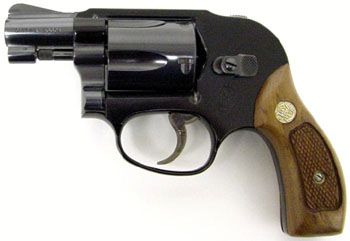Through some crazy trade that involved guns money and ammo I just became an owner of a vintage ca. 1960, S&W Model 38. It's a cool little snub-nose with aluminum frame. The main reason I agreed to own it is because I recently shot Ruger LCR and realized that shooting snubs with fixed sights is a different experience from shooting long-barreled revolvers with target sights. My accuracy was mediocre and hopefully this little beauty will help me improve it. I have a few questions about this revolver though...
The gun seems to be pretty clean. It has a shiny bore and good lockup with a very little play, so I don't expect any unpleasant surprises on the range. However the gun shows a fair amount of finish wear... On the frame it has a bunch of little "dots" where finish flaked from the aluminum. Structurally this is irrelevant as aluminum does not rust , but if there is a fairly inexpensive way to touch up the finish, please let me know. If not, I can leave it alone, it's not that bad.
The second question I have is whether this gun can handle +P ammo. It's a pretty old gun and I am not sure if it's strong enough for it. Please let me know. Thanks.

Image shamelessly stolen from the Internet
The gun seems to be pretty clean. It has a shiny bore and good lockup with a very little play, so I don't expect any unpleasant surprises on the range. However the gun shows a fair amount of finish wear... On the frame it has a bunch of little "dots" where finish flaked from the aluminum. Structurally this is irrelevant as aluminum does not rust , but if there is a fairly inexpensive way to touch up the finish, please let me know. If not, I can leave it alone, it's not that bad.
The second question I have is whether this gun can handle +P ammo. It's a pretty old gun and I am not sure if it's strong enough for it. Please let me know. Thanks.

Image shamelessly stolen from the Internet

